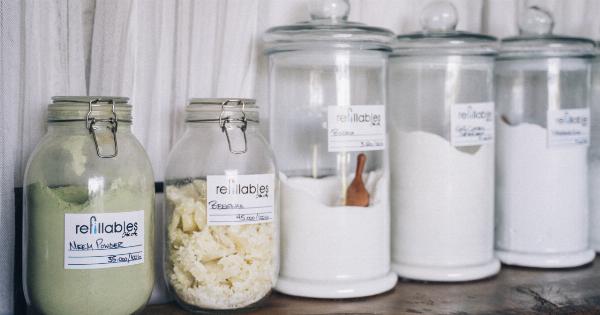Osteoarthritis is a degenerative joint disease that affects millions of people worldwide, particularly those over the age of 50. It is characterized by the breakdown of the cartilage in joints, leading to pain, stiffness, and reduced mobility.
While there is no cure for osteoarthritis, there are several herbs that can help soothe symptoms and improve overall joint health. In this article, we will explore 10 herbs that are particularly effective for managing osteoarthritis.
Turmeric
Turmeric is a spice commonly used in Indian cuisine that contains a compound called curcumin, which has powerful anti-inflammatory and antioxidant properties.
Studies have shown that curcumin can reduce joint inflammation, pain, and stiffness in people with osteoarthritis. Additionally, turmeric has been found to protect cartilage from further damage and even promote its regeneration. Turmeric can be consumed in supplement form or added to food as a spice.
Ginger
Ginger is a root that has been used for centuries in traditional medicine to treat a wide variety of ailments, including osteoarthritis. Like turmeric, ginger contains anti-inflammatory compounds that can help reduce joint pain and stiffness.
A study published in the journal Arthritis & Rheumatism found that ginger extract reduced knee pain by 40 percent in people with osteoarthritis. Ginger can be consumed as a tea or added to food as a spice.
Boswellia
Boswellia is a resin extracted from the bark of the Boswellia tree, which is native to India. It has been used for centuries in Ayurvedic medicine to treat arthritis and other inflammatory conditions.
Boswellia contains compounds that inhibit the production of inflammatory molecules in the body, which can help relieve pain and swelling in joints. A study published in the International Journal of Medical Sciences found that Boswellia extract significantly reduced knee pain and improved knee function in people with osteoarthritis.
Willow Bark
Willow bark is a natural pain reliever that has been used for centuries to treat aches and pains. It contains a compound called salicin, which is similar to aspirin and has anti-inflammatory properties.
Studies have shown that willow bark can help reduce joint pain and stiffness in people with osteoarthritis. Willow bark can be consumed as a tea or taken in supplement form.
Cayenne
Cayenne pepper contains a compound called capsaicin, which has been found to reduce joint pain and inflammation. Capsaicin works by blocking the transmission of pain signals from the nerves to the brain.
A study published in the Journal of Pain found that applying capsaicin cream to the skin reduced knee pain in people with osteoarthritis. Cayenne can be added to food as a spice or taken in capsule form.
Devil’s Claw
Devil’s claw is a root that has been used for centuries in traditional medicine to treat arthritis and other inflammatory conditions. It contains compounds that have anti-inflammatory and analgesic properties.
A study published in the Journal of Rheumatology found that devil’s claw extract significantly reduced knee pain and improved knee function in people with osteoarthritis. Devil’s claw can be consumed in supplement form or made into a tea.
Cat’s Claw
Cat’s claw is a vine that grows in the Amazon rainforest and has been used for centuries by indigenous people to treat inflammation and pain. It contains compounds that have anti-inflammatory and antioxidant properties.
A study published in the journal Inflammopharmacology found that cat’s claw extract reduced joint pain and stiffness in people with osteoarthritis. Cat’s claw can be consumed in supplement form or made into a tea.
Guggul
Guggul is a resin extracted from the Commiphora mukul tree, which is native to India. It has been used for centuries in Ayurvedic medicine to treat arthritis and other inflammatory conditions.
Guggul contains compounds that have anti-inflammatory and analgesic properties. A study published in the Indian Journal of Pharmacology found that guggul extract reduced joint pain and stiffness in people with osteoarthritis. Guggul can be consumed in supplement form or made into a tea.
Stinging Nettle
Stinging nettle is a plant that has been used for centuries to treat a wide variety of conditions, including arthritis. It contains compounds that have anti-inflammatory and analgesic properties.
A study published in the Journal of Herbal Pharmacotherapy found that stinging nettle extract reduced joint pain and stiffness in people with osteoarthritis. Stinging nettle can be consumed in supplement form or made into a tea.
Green Tea
Green tea is a beverage that is consumed worldwide and contains a compound called epigallocatechin gallate (EGCG), which has anti-inflammatory and antioxidant properties.
Studies have shown that EGCG can help reduce joint inflammation and prevent cartilage breakdown in people with osteoarthritis. Additionally, green tea has been found to have a protective effect on bone density, which can be beneficial for people with osteoarthritis. Green tea can be consumed in beverage form or taken in supplement form.
Conclusion
Osteoarthritis is a chronic condition that can greatly affect a person’s quality of life. While conventional treatments such as pain medication and surgery can be effective, they often come with side effects and risks.
For many people, herbs can be a safe and effective way to manage osteoarthritis symptoms and improve joint health. By incorporating these 10 herbs into their daily routine, people with osteoarthritis can experience relief from pain, stiffness, and inflammation.































